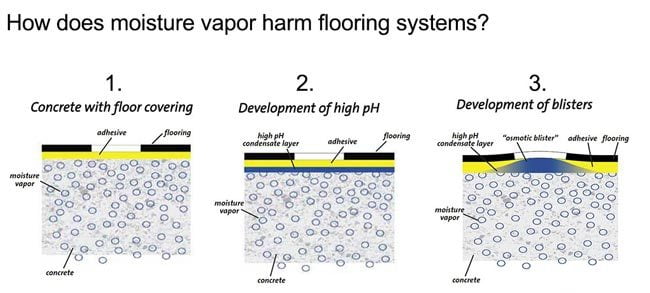Concrete may look and feel hard, dry and seemingly water tight but concrete actually resembles a hard, dry sponge more than something solid and impermeable. In fact, concrete’s interior is comprised of thousands of microscopic pores that fill with water as the concrete is being poured and set. Once concrete starts to harden, its hydration reaction to hardening uses some of this water. When moisture near the surface of the concrete slab begins evaporating, these tiny pores dry out.
Once water is depleted in a concrete floor, moisture vapor continues to diffuse through the slab from the soil’s moisture content if no vapor barrier exists between the soil and the concrete. Lack of a moisture vapor barrier means the concrete slab will act as a thirsty sponge–which seriously compromises the integrity of adhesives, flooring materials and coatings by causing bubbling, discolorations and structural deformities.
Moisture Vapor Transmission Cause Flooring Failure
Excess moisture below or inside concrete slabs is responsible for most coating failures. Although moisture in concrete is needed during applications of epoxy materials, this kind of moisture does not cause the coating failures that occur months or years later. Rather, it is the flow of vapor–moisture vapor transmission–that causes the majority of adhesion concrete floor problems. How to significantly reduce vapor transmission in concrete slabs-on-grade is the biggest issue surrounding the moisture vapor transmission phenomenon.
In fact, the negative consequences of unchecked MVT through concrete slabs have increased dramatically over the past few years in the construction industry. Fueled by “fast-track” building practices, restrictions on the use of volatile organic curing compounds and behavioral changes of modern adhesives and floor coverings, the problem of MVT has contributed heavily to discussions about vapor barrier positioning beneath floors, especially in distribution centers and large warehouses where resilient carpet and tile constitutes the majority of adhered finishes.
What is Moisture Vapor Transmission Rate?
MVTR measures the passage of water vapor through any substance, including concrete. Controlling moisture levels is critical in many industries where excess moisture can reduce the shelf life, safety and quality of pharmaceutical and food products.
The American Society for Testing and Materials (ASTM) states that moisture vapor transmission rates of four pounds per 1000 square feet over a 24-hour period is the maximum rate allowable for successfully covering concrete with adhesive, sealer or coating. MVTR can be determined by doing a calcium chloride test involving the placement of unhydrated calcium chloride on a concrete slab and covering it with a domed, plastic lid. The calcium chloride is then weighed (after 72 hours) to determine the amount of moisture it has absorbed from the concrete.
A faster method of testing MVT is called in-situ relative humidity testing ,which can be accomplished in minutes instead of hours. The downside of this method is that you must drill a 1/2 inch hole into the concrete to insert a probe for measuring moisture content.
Controlling Moisture Vapor Transmission in Concrete
Installing adequate moisture control vapor barriers and flooring using commercial/industrial grade epoxy or urethane coatings are the best way to control MVT. The lifespan of concrete is prolonged using this type of coating by preventing disintegration of concrete and allowing surface treatments to remain in excellent condition for the duration.
A vapor barrier’s effectiveness in controlling moisture movement is measured by its perm rating. A permeance of one perm is one grain of water vapor that transmits at one square foot per hour per one inch of mercury vapor pressure difference. Consequently, good vapor barriers have lower numbers. Materials presenting permeance ratings better than 1.0 are typically not considered to be genuine vapor barriers.
Anti-moisture vapor transmission flooring prevents erosive forces from permeating concrete and causing serious degradation. When concrete slabs intended to receive an impermeable surfacing or coating are being placed, an effective moisture vapor barrier must be established. Also be aware that adhesion issues caused by MVT are not limited to epoxy bonding to concrete. Any other non-breathing films will react in this manner as well.
Once the barrier is in place, using high quality concrete and professional placement techniques are essential to completely eliminate MVT. Structural integrity and configuration of the concrete slab should be considered, along with precision design of expansion and control joints. A properly cured, well-placed concrete slab will provide a dense, hard concrete surface exhibiting the desired low permeability.
The SANI-TRED® Solution
Epoxy or polyaspartic systems simply do not work for extended periods of time on exterior applications and often fail because they can’t hold back the vapor pressure exerted on them in an outdoor setting. The same thing goes for many basement floors or other areas where moisture vapor pressure is an issue, resulting in concrete floor problems. SANI-TRED on the other hand is a different animal!
Its flexible rubber “tentacle-like fingers” penetrate deep (sometimes up to 1.5 inches deep) within prepared concrete. When moisture vapor/pressure presses against them they expand and swell tightly against the concrete capillaries making it impossible to blow off the coating! Learn more about using SANI-TRED as a concrete vapor barrier sealer on our site!

